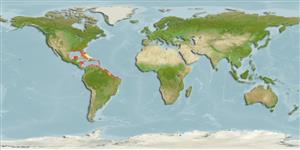>
Gobiiformes (Gobies) >
Gobiidae (Gobies) > Gobionellinae
Etymology: Gobionellus: Diminutive of Latin, gobius = gudgeon (Ref. 45335).
More on author: Pallas.
Environment: milieu / climate zone / depth range / distribution range
Écologie
marin; eau douce; saumâtre démersal; amphidrome (Ref. 46888). Tropical; 11°C - 29°C (Ref. 97140); 37°N - 36°S, 98°W - 34°W
Western Atlantic: USA (Virginia) to southern Brazil; occasionally taken as far north as Great Bay estuary, New Jersey; including Mississippi Sound, Gulf of Mexico off Port Aransas, Texas; the muddy coast of French Guiana and especially common along the lower Cayenne River.
Taille / Poids / Âge
Maturity: Lm ? range ? - ? cm
Max length : 27.0 cm TL mâle / non sexé; (Ref. 122735); common length : 4.7 cm TL mâle / non sexé; (Ref. 12193); poids max. publié: 73.30 g (Ref. 122735)
Épines dorsales (Total) : 7; Rayons mous dorsaux (Total) : 12 - 14; Épines anales: 1; Rayons mous anaux: 13 - 14. This species differs from its congeners by the following characters: mouth terminal and oblique; most distinct pigmentation, a large blotch on trunk located anterodorsally beneath pectoral fin; opercle with a triangular patch; pectoral-fin base with a blotch; second dorsal-fin 14 elements, anal fin with 15 elements; dorsal fins separate; adults with small ctenoid scales covering trunk and nape, 57-89 scales in a lateral series; upper jaw with several rows of teeth; first gill arch with 8 thin rakers on ceratobranchial, 1at the angle, and 6 or 7 on epibranchial (Ref. 55435).
Adults are found on shallow mud or mud-sand bottoms in turbid and generally brackish water near estuaries (Ref. 13628). Also encountered in weedy backwaters (Ref. 7251) and hyper-saline waters (Ref. 13628) with salinity ranging from 0.15 to 37.2 ppt (Ref. 97140).
Life cycle and mating behavior
Maturities | Reproduction | Spawnings | Egg(s) | Fecundities | Larves
Benthic spawner.
Pezold, F., 2004. Redescriptions and synonymies of species of the American-west African genus Gobionellus (Teleostei: Gobiidae) with a key to species. Copeia 2004(2):281-297. (Ref. 55435)
Statut dans la liste rouge de l'IUCN (Ref. 130435)
Menace pour l'homme
Harmless
Utilisations par l'homme
Outils
Articles particuliers
Télécharger en XML
Sources Internet
Estimates based on models
Preferred temperature (Ref.
123201): 23.3 - 28.1, mean 27.2 °C (based on 932 cells).
Phylogenetic diversity index (Ref.
82804): PD
50 = 0.5078 [Uniqueness, from 0.5 = low to 2.0 = high].
Bayesian length-weight: a=0.00537 (0.00343 - 0.00840), b=2.93 (2.80 - 3.06), in cm total length, based on LWR estimates for this species & (Sub)family-body (Ref.
93245).
Niveau trophique (Ref.
69278): 3.7 ±0.5 se; based on size and trophs of closest relatives
Résilience (Ref.
120179): Milieu, temps minimum de doublement de population : 1,4 à 4,4 années (Preliminary K or Fecundity.).
Fishing Vulnerability (Ref.
59153): Low vulnerability (17 of 100).
Nutrients (Ref.
124155): Calcium = 242 [124, 519] mg/100g; Iron = 1.26 [0.71, 2.26] mg/100g; Protein = 17.9 [16.1, 19.4] %; Omega3 = 0.254 [0.110, 0.478] g/100g; Selenium = 36.5 [19.4, 75.5] μg/100g; VitaminA = 31.7 [10.2, 82.7] μg/100g; Zinc = 1.96 [1.38, 2.83] mg/100g (wet weight);
